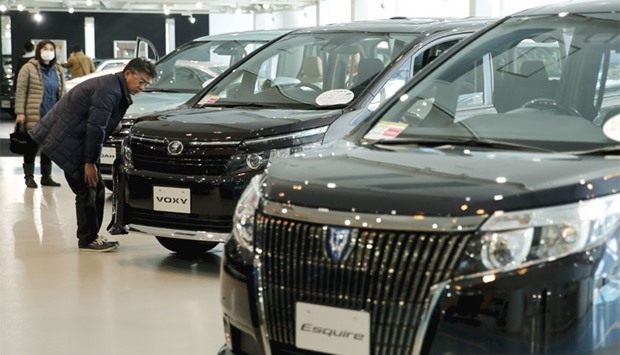Toyota should be cruising in the fast lane of global automakers right now. So why is its share price stuck in traffic? It’s regained the crown of world’s largest automaker from Volkswagen, and earned a little schadenfreude too after its German rival was left spinning its wheels in an emissions-fraud morass.
Negative interest rates from the Bank of Japan should also provide a wind at its back. But if you think the shares’ 12% fall this year looks modest in the context of January’s market turmoil, take a look where Toyota stands in valuation terms: The problem is growth. The shot in the arm from the 2012 election of Shinzo Abe and depreciation of the Japanese yen has all but worked its way out of Toyota’s system. Its year-on-year revenue growth of 2.4% reported Friday was the slowest in six quarters, and will head into negative territory for the first time since 2011 in the current quarter if the company doesn’t beat its full-year forecast of ¥27.5tn. While the company announced a share buyback and lifted its forecast for net income to ¥2.27tn in the year ending in March, that figure remains well short of the ¥2.39tn median estimate from 25 analysts surveyed by Bloomberg. Indeed, all but one of the analysts is expecting a higher figure, and Toyota has at best a mixed record in beating forecasts.
In many ways, the company appears to have entered the Apple trap: Investors are in mourning for a period of blistering growth that the company has grown too large to replicate.
Toyota fourth-quarter revenue growth forecast -14.75%. Turning this situation around will require more advances outside rich countries. Emerging markets have been out of fashion of late, but they remain crucial for automakers’ long-term futures as other regions approach saturation. The US auto fleet looks to have completed the restocking cycle it entered in the wake of the 2008 financial crisis, with monthly sales now back to pre-crisis highs. Growth from here looks likely to be more modest. The UK saw record registrations last year but appears to have been pushed into bubble territory by over-generous financing, according to Gadfly’s Chris Bryant.
Despite this, Japan, North America and Europe continue to take the lion’s share of Toyota’s global sales: Those used to Toyota’s seemingly supernatural dominance in developed countries may be surprised to see how much it struggles to make headway elsewhere. In China, the world’s biggest car market, it’s been losing ground to Honda faster than it’s been gaining on market leader Nissan, according to data obtained by Bloomberg’s Ma Jie. If unit sales continue this year at 2015’s pace, it will be pushed to last place among the big three Japanese automakers.
In India, which IHS automotive forecasts will become the world’s third-biggest auto market by 2019, it trails Maruti Suzuki, Hyundai and Honda in most size categories. One motivation behind Toyota’s drive to take full control of mini-car subsidiary Daihatsu could be to improve its position in a country where smaller cars account for more than 80% of the market. Toyota is studying whether to introduce the Daihatsu brand domestically, its India head Naomi Ishii told Bloomberg News’s Siddharth Philip this week.
The situation is far from critical. Toyota’s net income margins have risen smartly in recent years, hitting their highest level since at least 2002 in the June quarter. In contrast to the popular image of Japan’s industrial sector, workforce productivity is also robust, with profit per 1,000 employees outstripping the level at most other global automakers: That provides some firepower to address Toyota’s shortcomings, but shareholders don’t appear to be giving management much credit. With its shares at a forward price- earnings ratio of 8.5, the company isn’t far above its low point of 8.2 during the teeth of the global financial crisis in October 2008. That seems too heavy a discount.

A man looks at Toyota cars at the company’s showroom in Tokyo. Japan, North America and Europe continue to take the lion’s share of the Japanese firm’s global sales but in China, the world’s biggest car market, it’s been losing ground to Honda faster than it’s been gaining on market leader Nissan, according to data obtained by Bloomberg.


